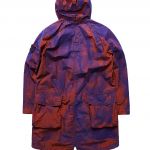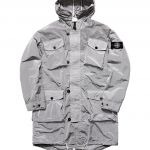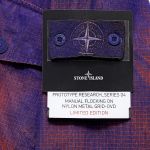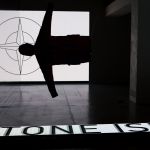
Stone Island Research Series 04 Release Info
The Manual Flocking on Nylon Metal Grid Jacket is coming in a strictly limited edition
May 20th, 2019
Filippo D'Asaro
Update 20.05.19
After the presentation at Milan Design Week, where the latest manifestation of Stone Island's Prototype Research series was unveiled. Today sees the details of the strictly limited edition release of the presented Manual Flocking on Nylon Metal Grid jacket.
A fishtail parka in Nylon Metal, the iconic iridescent shining Stone Island fabric, undergoes a cutting-edge artisanal flocking procedure, executed by highly specialized personnel. The parka is then sprayed with a water-based adhesive and exposed thereafter to the cotton flock. Created in a limited edition of only 100 pieces worldwide, with each piece being individually numbered, we highly recommend you don't sleep if you want a chance to cop one of these rarities.
Exclusively available via Stone Island online starting from Thursday, 23 May starting from 4pm CET.
Check out our exclusive interview with Stone Island head, Carlo Rivetti here.

Milan design week is well underway and among the multitude of excellent events, Design Week is that little bit extra special as it's the one time per year that Stone Island presents a slice of their very latest innovations under the banner of the Stone Island_Prototype Research_Series. Happening at their Milan showroom on via Savona, it’s a rare chance for the public to be allowed in to see the compound and have a little peek behind the doors of Stone Island. This year marks the 4th time the Research Series presentation takes place and we were there on the spot for a preview to take it all in, plus got the exclusive chance to sit down and talk with none other than Creative Director and President of Stone Island, Carlo Rivetti.


The flock fibrils are then magnetized so as to drift up towards the garment sticking to the applied adhesive. The creation of the electromagnetic field straightens the fibrils, which are attracted to the garment due to the uniqueness of this technique. As it sounds, the where and how these fibers will drift onto the piece are very much random and, as a result, create individually unique pieces every time. The garment is then dyed twice, as nylon and cotton react differently to dying procedures, ending up with a jacket that's given an extra-dimensional quality due to the tactile layer of the flock.
When sitting down with Rivetti, I first ask him a bit more about the process behind the research series. If they had specific goals in mind or if the results were more unforeseen, that they then thought of after how to implement? In other words, did fashion guide the science or did the science guide the fashion?
When we start, it really is pure experimentation, where we don’t actually know the final aspect of how it will be used. So let us put it in this way, technology is inspiring fashion, because if we then achieve something interesting, then the garment comes easily. Every time we start with the fabric and its treatment, then as I always say, it is the fabric itself that tells us how we have to use it. Sometimes we also do mistakes and that can result in something even better then what we were actually thinking.
Carlo Rivetti

Creative Director and President of Stone Island, Carlo Rivetti
The nylon fabric has a grid inside is (the ripstop) so it's not a flat Nylon metal textile, consisting of three strands of yarn, one black, one grey, and one white. After the glue is applied, inside the machine a magnetic field is created, which attracts the flock fibres to then stick onto the garment. We then double dye, and for this occasion we chose Red and Blue, but what I find interesting is if you only do it in single color, then the result is a much a more subtle shading, meaning that within the post dyeing process such vast amounts of different things can be achieved.
Carlo Rivetti
- A longer and deeper account of the interview with Carlo Rivetti will be published on nss in the near future -
The presentation at via Savona took the form of an art installation, designed by Ken-Tonio Yamamoto and Nina Heydorn, where the pre-dyed white piece hung on one side of the room with the finished product hanging on the other. Running underneath were rows of LED visuals that would fade between the colors of the prototype jacket that was suspended above. Occasionally the lights and sounds would crescendo up into a frenzy of stroboscopic colors as if to visualize the flocking that occurs within the magnetic field, in a very well executed manifestation of both sight and sound.


































.jpg)



















.jpg)



















